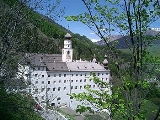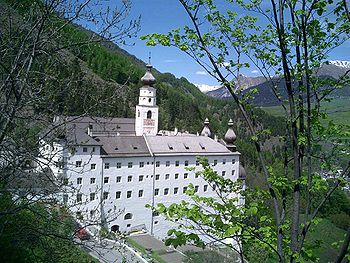
Marienberg Abbey
Encyclopedia

Abbey
An abbey is a Catholic monastery or convent, under the authority of an Abbot or an Abbess, who serves as the spiritual father or mother of the community.The term can also refer to an establishment which has long ceased to function as an abbey,...
in Mals
Mals
Mals is a comune in South Tyrol in the Italian region Trentino-Alto Adige/Südtirol, located about 80 km northwest of Trento and about 70 km northwest of Bolzano, on the border with Switzerland and Austria.-Geography:...
, Vinschgau in South Tyrol
South Tyrol
South Tyrol , also known by its Italian name Alto Adige, is an autonomous province in northern Italy. It is one of the two autonomous provinces that make up the autonomous region of Trentino-Alto Adige/Südtirol. The province has an area of and a total population of more than 500,000 inhabitants...
, northern Italy
Italy
Italy , officially the Italian Republic languages]] under the European Charter for Regional or Minority Languages. In each of these, Italy's official name is as follows:;;;;;;;;), is a unitary parliamentary republic in South-Central Europe. To the north it borders France, Switzerland, Austria and...
. It was founded in 1149 or 1150 by Ulrich von Tarasp
Tarasp
Tarasp is a municipality in the district of Inn in the Swiss canton of Graubünden. Its eleven settlements are situated within the Lower Engadin valley along the Inn River, at the foot of the Sesvenna Range....
and other nobles.
It has maintained a long tradition of education and, at 1,340 m, it is Europe
Europe
Europe is, by convention, one of the world's seven continents. Comprising the westernmost peninsula of Eurasia, Europe is generally 'divided' from Asia to its east by the watershed divides of the Ural and Caucasus Mountains, the Ural River, the Caspian and Black Seas, and the waterways connecting...
’s highest abbey. It retains a Baroque
Baroque architecture
Baroque architecture is a term used to describe the building style of the Baroque era, begun in late sixteenth century Italy, that took the Roman vocabulary of Renaissance architecture and used it in a new rhetorical and theatrical fashion, often to express the triumph of the Catholic Church and...
style with Romanesque
Romanesque architecture
Romanesque architecture is an architectural style of Medieval Europe characterised by semi-circular arches. There is no consensus for the beginning date of the Romanesque architecture, with proposals ranging from the 6th to the 10th century. It developed in the 12th century into the Gothic style,...
elements, and has some well-maintained fresco
Fresco
Fresco is any of several related mural painting types, executed on plaster on walls or ceilings. The word fresco comes from the Greek word affresca which derives from the Latin word for "fresh". Frescoes first developed in the ancient world and continued to be popular through the Renaissance...
s.
History
The history of the foundation goes back to CharlemagneCharlemagne
Charlemagne was King of the Franks from 768 and Emperor of the Romans from 800 to his death in 814. He expanded the Frankish kingdom into an empire that incorporated much of Western and Central Europe. During his reign, he conquered Italy and was crowned by Pope Leo III on 25 December 800...
, who established a Benedictine monastery
Monastery
Monastery denotes the building, or complex of buildings, that houses a room reserved for prayer as well as the domestic quarters and workplace of monastics, whether monks or nuns, and whether living in community or alone .Monasteries may vary greatly in size – a small dwelling accommodating only...
between 780 and 786 near Taufers, a town which on the Vinschgau side of the border with Switzerland, in Val Müstair
Val Müstair
Val Müstair is a municipality in the district of Inn in the Swiss canton of Graubünden. It was formed on 1 January 2009 through the merger of Tschierv, Fuldera, Lü, Valchava, Santa Maria Val Müstair and Müstair.-Demographics:...
(monastery valley).
Sometime after 880, the Benedictine monastery was dissolved and re-established as a convent for both sexes. About two hundred years later there was a reorganization, when Eberhard of Tarasp built the monastery of Schuls in the Inn
Inn River
The Inn is a river in Switzerland, Austria and Germany. It is a right tributary of the Danube and is approximately 500km long. The highest point of its drainage basin is the summit of Piz Bernina, at 4,049 metres.- Geography :...
valley in the Engadin
Engadin
The Engadin or Engadine is a long valley in the Swiss Alps located in the canton of Graubünden in southeast Switzerland. It follows the route of the Inn River from its headwaters at Maloja Pass running northeast until the Inn flows into Austria one hundred kilometers downstream...
for the male portion of the community, while nuns remained at Taufers in the Adige
Adige
The Adige is a river with its source in the Alpine province of South Tyrol near the Italian border with Austria and Switzerland. At in length, it is the second longest river in Italy, after the River Po with ....
valley. After the monastery at Schuls had been rebuilt and reconsecrated in 1131, Ulrich von Tarasp called monks from the German monastery of Ottobeuren
Ottobeuren Abbey
Ottobeuren is a Benedictine abbey, located in Ottobeuren, near Memmingen in the Bavarian Allgäu, Germany.-First foundation:It was founded in 764 by Blessed Toto, and dedicated to St. Alexander, the martyr. Of its early history little is known beyond the fact that Toto, its first abbot, died about...
to revive it; the additional numbers made it possible to raise the community from a priory to an abbey. In 1149 or 1150 the community was re-settled on the hill near the village of Burgeis
Burgeis
thumb|250px|Burgeis and the Marienberg AbbeyBurgeis is the largest frazione of the commune of Mals and sits at an altitude of 1216m in Vinschgau in South Tyrol beneath the mountain Watles on the upper reaches of the Adige. The name goes all the way back to a Roman founding, as a fort on the "Via...
, under the name of Marienberg.
About one hundred years after its foundation the abbey suffered from serious conflict. It was sacked twice by nobles under Abbot Konrad III (1271-98) and in 1304 Abbot Hermann was killed by Ulrich of Matsch. The Black Death
Black Death
The Black Death was one of the most devastating pandemics in human history, peaking in Europe between 1348 and 1350. Of several competing theories, the dominant explanation for the Black Death is the plague theory, which attributes the outbreak to the bacterium Yersinia pestis. Thought to have...
killed all but four members of the abbey including Abbot Wyho and Goswin, a lay brother, who later became a priest and chronicled the history of the monastery. This chronicle is divided into three books, the first of which details the story of the foundation and donations to the abbey. The second book of the chronicle is a history of the abbots, and the third recites the privileges conferred by popes and princes. It gives an account, without regard for order or chronology, of the founders, fortunes, benefactors and oppressors of the monastery. Goswin later became a prior of the abbey and court chaplain to Duke Leopold III of Austria.
In 1418 Marienberg was burned down and was later rebuilt.
After a period of decline in the sixteenth century, several German
Germany
Germany , officially the Federal Republic of Germany , is a federal parliamentary republic in Europe. The country consists of 16 states while the capital and largest city is Berlin. Germany covers an area of 357,021 km2 and has a largely temperate seasonal climate...
monks helped to restore and expand the abbey. Abbot Mathias Lang (1615-40), from Weingarten Abbey
Weingarten Abbey
Weingarten Abbey or St. Martin's Abbey is a Benedictine monastery on the Martinsberg in Weingarten near Ravensburg in Baden-Württemberg .-First foundation:...
, reformed it, and in 1634 Marienberg joined the Benedictine Congregation of Swabia. Lang's successor, Jacob Grafinger (1640-53), enlarged the library, and made the younger members finish their education at schools of repute. In 1656 the abbey was again burned down. Abbot Johann Baptist Murr (1705-32) in 1724 founded a humanistic high school in Meran which is still administered by the monks of Marienberg. Abbot Placidus Zobel (1782-1815) compiled a chronicle of the abbots.
In 1807 Marienberg was dissolved by the Bavaria
Bavaria
Bavaria, formally the Free State of Bavaria is a state of Germany, located in the southeast of Germany. With an area of , it is the largest state by area, forming almost 20% of the total land area of Germany...
n government, but was restored by Emperor Francis II in 1816.
Today the monks specialise in adult education: weekend courses and longer retreats are held at the abbey. The abbey itself is available for tours.
External links
- Marienberg Abbey entry in the Catholic EncyclopediaCatholic EncyclopediaThe Catholic Encyclopedia, also referred to as the Old Catholic Encyclopedia and the Original Catholic Encyclopedia, is an English-language encyclopedia published in the United States. The first volume appeared in March 1907 and the last three volumes appeared in 1912, followed by a master index...
- Marienberg Abbey
- Information about the abbey

